Lead-Free FACsSnI3 Based Perovskite Solar Cell: Designing Hole and Electron Transport Layer
Abstract
1. Introduction
2. Device Modeling and Simulation Methods
2.1. Simulation Device Models
2.1.1. Poisson Model
2.1.2. Continuity Model
2.1.3. Charge Transport Model
2.1.4. Optical Absorption Model
2.2. Simulation Software
- (i)
- The nature of the simulation software.
- (ii)
- The capacity of the simulation software.
- (iii)
- The variety of available models.
- (iv)
- The well-defined workflow to execute the task.
- (v)
- The numerical approaches used to solve the models.
- (vi)
- The defined accuracy of the internal and external variables.
- (vii)
- The user-friendliness of the software.
- (viii)
- The continuous improvement feedback cycle.
2.3. Design of Proposed Solar Cell
2.4. Simulation Materials Parameters
| Photovoltaic Parameters | Symbol | Unit | Hole-Transport Layer | Electron-Transport Layer | FACsSnI3 |
|---|---|---|---|---|---|
| Thickness | Th | nm | 200 | 200 | 200 |
| Energy Band Gap | Eg | eV | 2 | 3.4 | 1.45 |
| Electron Affinity | χ | eV | 3 | 4 | 4.1 |
| Dielectric Permittivity | ϵr | 18 | 9 | 9 | |
| Effective Density of States at Conduction Band | Nc | cm−3 | 2 × 1020 | 2 × 1020 | 6 × 1018 |
| Effective Density of States at Valence Band | Nv | cm−3 | 2 × 1020 | 2 × 1020 | 2.14 × 1019 |
| Hole Thermal Velocity | Vh | cm/s | 1 × 107 | 1 × 107 | 1 × 107 |
| Electron Thermal Velocity | Ve | cm/s | 1 × 107 | 1 × 107 | 1 × 107 |
| Electron Mobility | µe | cm−2/V·s | 4 × 10−4 | 200 | 2.36 × 10−1 |
| Hole Mobility | µh | cm−2/V·s | 4 × 10−4 | 80 | 1.7 × 10−1 |
| Uniform Shallow Donor Doping | Nd | cm−3 | - | 1 x1016 | 1 × 1019 |
| Uniform Shallow Acceptor Doping | Na | cm−3 | 1 x1016 | - | 1 × 1019 |
| Defect Density | Nt | cm−3 | 1 × 1014 | 1 × 1014 | 1 × 1014 |
| References | [56,57,58,59,60] |
2.5. Simulation Flowchart
- Step 4: Set the thickness of the FACsSnI3 absorber layer to a minimum and gradually increase it up to the maximum of the range.
- o
- Step 4a: Determine the optimum EA of the hole-transport layer through simulation, which gives max PCE. Update the simulation parameter for electron affinity (hole-transport layer).
- o
- Step 4b: Determine the optimum Eg of the hole-transport layer, which gives max PCE. Update the simulation parameter for Eg (hole-transport layer).
- o
- Step 4c: Determine the optimum EA of the electron-transport layer, which gives max PCE. Update the simulation parameter for EA (electron-transport layer).
- o
- Step 4d: Determine the optimum Eg of the electron-transport layer, which gives max PCE. Update the simulation parameter for Eg (electron-transport layer).
- o
- Step 4e: Determine the optimum thickness of the hole-transport layer, which gives max PCE. Update the simulation parameter for thickness (hole-transport layer).
- o
- Step 4f: Determine the optimum Na of the hole-transport layer, which gives max PCE. Update the simulation parameter for Na (hole-transport layer).
- o
- Step 4g: Determine the optimum thickness of the electron-transport layer, which gives max PCE. Update the simulation parameter for thickness (electron-transport layer).
- o
- Step 4h: Determine the optimum Nd of the electron-transport layer, which gives max PCE. Update the simulation parameter for Nd (electron-transport layer).
- o
- If the thickness loop of the FACsSnI3 is not exhausted, then go to Step 4a.
- Step 5: Determine the thickness of FACsSnI3 which gives the maximum PCE with ideal hole-transport layer and electron-transport layer parameters.
- Step 6: Determine the photocurrent-voltage response of the optimized device with an ideal hole-transport layer and electron-transport layer.
- Step 7: Determine the other responses of the optimized device with an ideal hole-transport layer and electron-transport layer.
- End of simulation.
3. Results and Discussion
3.1. Optimization of Electron Affinity for Hole-Transport Layer
3.2. Optimization of Energy Bandgap for Hole-Transport Layer
3.3. Optimization of Electron Affinity for Electron-Transport Layer
3.4. Optimization of Energy Bandgap for Electron-Transport Layer
3.5. Optimization of Film Thickness for Hole-Transport Layer
3.6. Optimization of Doping Density for Hole-Transport Layer
3.7. Optimization of Film Thickness for Electron-Transport Layer
3.8. Optimization of Doping Density for Electron-Transport Layer
3.9. Optimization of Thickness for FACsSnI3 Absorber Layer
3.10. Overall Photovoltaic Response of the Optimized Solar Cell
4. Conclusions
Author Contributions
Funding
Data Availability Statement
Acknowledgments
Conflicts of Interest
References
- Shao, M.; Bie, T.; Yang, L.; Gao, Y.; Jin, X.; He, F.; Zheng, N.; Yu, Y.; Zhang, X. Over 21% efficiency stable 2D perovskite solar cells. Adv. Mater. 2022, 34, 2107211. [Google Scholar] [CrossRef] [PubMed]
- Rong, Y.; Hu, Y.; Mei, A.; Tan, H.; Saidaminov, M.I.; Seok, S.I.; McGehee, M.D.; Sargent, E.H.; Han, H. Challenges for commercializing perovskite solar cells. Science 2018, 361, eaat8235. [Google Scholar] [CrossRef] [PubMed]
- Liu, J.; Aydin, E.; Yin, J.; De Bastiani, M.; Isikgor, F.H.; Rehman, A.U.; De Wolf, S. 28.2%-efficient, outdoor-stable perovskite/silicon tandem solar cell. Joule 2021, 5, 3169–3186. [Google Scholar] [CrossRef]
- Babayigit, A.; Ethirajan, A.; Muller, M.; Conings, B. Toxicity of organometal halide perovskite solar cells. Nat. Mater. 2016, 15, 247–251. [Google Scholar] [CrossRef] [PubMed]
- Ding, G.; Zheng, Y.; Xiao, X.; Cheng, H.; Zhang, G.; Shi, Y.; Shao, Y. Sustainable development of perovskite solar cells: Keeping a balance between toxicity and efficiency. J. Mater. Chem. A 2022, 10, 8159–8171. [Google Scholar] [CrossRef]
- Bibi, A.; Lee, I.; Nah, Y.; Allam, O.; Kim, H.; Quan, L.; Tang, J.; Walsh, A.; Jang, S.; Sargent, E.; et al. Lead-free halide double perovskites: Toward stable and sustainable optoelectronic devices. Mater. Today 2021, 49, 123–144. [Google Scholar] [CrossRef]
- Wu, C.; Zhang, Q.; Liu, Y.; Luo, W.; Guo, X.; Huang, Z.; Ting, H.; Sun, W.; Zhong, X.; Wei, S.; et al. The Dawn of Lead-Free Perovskite Solar Cell: Highly Stable Double Perovskite Cs2AgBiBr6 Film. Adv. Sci. 2017, 5, 1700759. [Google Scholar] [CrossRef]
- Zhang, W.; Cai, Y.; Liu, H.; Xia, Y.; Cui, J.; Shi, Y.; Chen, R.; Shi, T.; Wang, H.L. Organic-Free and Lead-Free Perovskite Solar Cells with Efficiency over 11%. Adv. Energy Mater. 2022, 12, 2202491. [Google Scholar] [CrossRef]
- Giustino, F.; Snaith, H.J. Toward lead-free perovskite solar cells. ACS Energy Lett. 2016, 1, 1233–1240. [Google Scholar] [CrossRef]
- Mora-Herrera, D.; Pal, M. Path toward the Performance Upgrade of Lead-Free Perovskite Solar Cells Using Cu2ZnSn1–xGexS4 as a Hole Transport Layer: A Theoretical Simulation Approach. J. Phys. Chem. C 2022, 126, 5847–5862. [Google Scholar] [CrossRef]
- Ustinova, M.I.; Babenko, S.D.; Luchkin, S.Y.; Talalaev, F.S.; Anokhin, D.V.; Olthof, S.; Troshin, P.A. Experimental evaluation of indium (i) iodide as a lead-free perovskite-inspired material for photovoltaic applications. J. Mater. Chem. C 2022, 10, 3435–3439. [Google Scholar] [CrossRef]
- Bello, O.O.; Emetere, M.E. Progress and limitation of lead-free inorganic perovskites for solar cell application. Sol. Energy 2022, 243, 370–380. [Google Scholar] [CrossRef]
- Cao, W.; Hu, Z.; Lin, Z.; Guo, X.; Su, J.; Chang, J.; Hao, Y. Defects and doping engineering towards high performance lead-free or lead-less perovskite solar cells. J. Energy Chem. 2022, 68, 420–438. [Google Scholar] [CrossRef]
- Conings, B.; Drijkoningen, J.; Gauquelin, N.; Babayigit, A.; D’Haen, J.; D’Olieslaeger, L.; Boyen, H.G. Intrinsic thermal instability of methylammonium lead trihalide perovskite. Adv. Energy Mater. 2015, 5, 1500477. [Google Scholar] [CrossRef]
- Al-Amri, A.M.; Cheng, B.; He, J.H. Perovskite methylammonium lead trihalide heterostructures: Progress and challenges. IEEE Trans. Nanotechnol. 2018, 18, 1–12. [Google Scholar] [CrossRef]
- Moiz, S.A.; Alahmadi, A.N. Design of dopant and lead-free novel perovskite solar cell for 16.85% efficiency. Polymers 2021, 13, 2110. [Google Scholar] [CrossRef]
- Moiz, S.A.; Alahmadi AN, M.; Aljohani, A.J. Design of a Novel Lead-Free Perovskite Solar Cell for 17.83% Efficiency. IEEE Access 2021, 9, 54254–54263. [Google Scholar] [CrossRef]
- Jokar, E.; Chien, C.-H.; Tsai, C.-M.; Fathi, A.; Diau, E.W.-G. Robust Tin-Based Perovskite Solar Cells with Hybrid Organic Cations to Attain Efficiency Approaching 10%. Adv. Mater. 2019, 31, e1804835. [Google Scholar] [CrossRef]
- Ke, W.; Stoumpos, C.C.; Kanatzidis, M.G. “Unleaded” perovskites: Status quo and future prospects of tin-based perovskite solar cells. Adv. Mater. 2019, 31, 1803230. [Google Scholar] [CrossRef]
- Ricciarelli, D.; Meggiolaro, D.; Ambrosio, F.; De Angelis, F. Instability of tin iodide perovskites: Bulk p-doping versus surface tin oxidation. ACS Energy Lett. 2020, 5, 2787–2795. [Google Scholar] [CrossRef]
- Treglia, A.; Ambrosio, F.; Martani, S.; Folpini, G.; Barker, A.J.; Albaqami, M.D.; De Angelis, F.; Poli, I.; Petrozza, A. Effect of electronic doping and traps on carrier dynamics in tin halide perovskites. Mater. Horiz. 2022, 9, 1763–1773. [Google Scholar] [CrossRef] [PubMed]
- Li, Z.; Li, X.; Wang, M.; Cai, M.; Shi, X.; Mo, Y.; Chen, X.; Ren, D.; Yang, M.; Liu, X.; et al. Enhanced photovoltaic performance via a bifunctional additive in tin-based perovskite solar cells. ACS Appl. Energy Mater. 2021, 5, 108–115. [Google Scholar] [CrossRef]
- Wang, Y.; Li, T.; Chen, X.; Zhang, L. High-performance flexible lead-free perovskite solar cells based on tin-halide perovskite films doped by reductant metal halide. Mater. Lett. 2022, 321, 132460. [Google Scholar] [CrossRef]
- Ozório, M.S.; Srikanth, M.; Besse, R.; Da Silva, J.L. The role of the A-cations in the polymorphic stability and optoelectronic properties of lead-free ASnI 3 perovskites. Phys. Chem. Chem. Phys. 2021, 23, 2286–2297. [Google Scholar] [CrossRef] [PubMed]
- Shi, T.; Zhang, H.S.; Meng, W.; Teng, Q.; Liu, M.; Yang, X.; Yan, Y.; Yip, H.L.; Zhao, Y.J. Effects of organic cations on the defect physics of tin halide Perovskites. J. Mater. Chem. A 2017, 5, 15124–15129. [Google Scholar] [CrossRef]
- Poli, I.; Kim, G.W.; Wong, E.L.; Treglia, A.; Folpini, G.; Petrozza, A. High external photoluminescence quantum yield in tin halide perovskite thin films. ACS Energy Lett. 2021, 6, 609–611. [Google Scholar] [CrossRef]
- Shao, S.; Liu, J.; Portale, G.; Fang, H.H.; Blake, G.R.; ten Brink, G.H.; Koster, L.J.A.; Loi, M.A. Highly reproducible Sn-based hybrid perovskite solar cells with 9% efficiency. Adv. Energy Mater. 2018, 8, 1702019. [Google Scholar] [CrossRef]
- Koh, T.M.; Krishnamoorthy, T.; Yantara, N.; Shi, C.; Leong, W.L.; Boix, P.P.; Grimsdale, A.C.; Mhaisalkar, S.G.; Mathews, N. Formamidinium tin-based perovskite with low E g for photovoltaic applications. J. Mater. Chem. A 2015, 3, 14996–15000. [Google Scholar] [CrossRef]
- Liao, W.; Zhao, D.; Yu, Y.; Grice, R.C.; Wang, C.; Cimaroli, A.; Schulz, P.; Meng, W.; Zhu, K.; Xiong, R.G.; et al. Lead-free inverted planar formamidinium tin triiodide perovskite solar cells achieving power conversion efficiencies up to 6.22%. Adv. Mater. 2016, 28, 9333–9340. [Google Scholar] [CrossRef]
- Li, G.; Su, Z.; Li, M.; Yang, F.; Aldamasy, M.H.; Pascual, J.; Yang, F.; Liu, H.; Zuo, W.; Di Girolamo, D.; et al. Ionic Liquid Stabilizing High-Efficiency Tin Halide Perovskite Solar Cells. Adv. Energy Mater. 2021, 11, 2101539. [Google Scholar] [CrossRef]
- Lee, S.J.; Shin, S.S.; Kim, Y.C.; Kim, D.; Ahn, T.K.; Noh, J.H.; Seo, J.; Seok, S.I. Fabrication of efficient formamidinium tin iodide perovskite solar cells through SnF2–pyrazine complex. J. Am. Chem. Soc. 2016, 138, 3974–3977. [Google Scholar] [CrossRef]
- Kim, H.; Lee, Y.H.; Lyu, T.; Yoo, J.H.; Park, T.; Oh, J.H. Boosting the performance and stability of quasi-two-dimensional tin-based perovskite solar cells using the formamidinium thiocyanate additive. J. Mater. Chem. A 2018, 6, 18173–18182. [Google Scholar] [CrossRef]
- Ran, C.; Gao, W.; Li, J.; Xi, J.; Li, L.; Dai, J.; Wu, Z. Conjugated organic cations enable efficient self-healing FASnI3 solar cells. Joule 2019, 3, 3072–3087. [Google Scholar] [CrossRef]
- Nie, R.; Sumukam, R.R.; Reddy, S.H.; Banavoth, M.; Seok, S.I. Lead-free perovskite solar cells enabled by hetero-valent substitutes. Energy Environ. Sci. 2020, 13, 2363–2385. [Google Scholar] [CrossRef]
- Yu, B.B.; Chen, Z.; Zhu, Y.; Wang, Y.; Han, B.; Chen, G.; Zhang, X.; Du, Z.; He, Z. Heterogeneous 2D/3D tin-halides perovskite solar cells with certified conversion efficiency breaking 14%. Adv. Mater. 2021, 33, 2102055. [Google Scholar] [CrossRef]
- Zillner, J.; Boyen, H.G.; Schulz, P.; Hanisch, J.; Gauquelin, N.; Verbeeck, J.; Küffner, J.; Desta, D.; Eisele, L.; Ahlswede, E.; et al. The Role of SnF2 Additive on Interface Formation in All Lead-Free FASnI3 Perovskite Solar Cells. Adv. Funct. Mater. 2022, 32, 2109649. [Google Scholar] [CrossRef]
- Liu, F.; Zhu, J.; Wei, J.; Li, Y.; Lv, M.; Yang, S.; Zhang, B.; Yao, J.; Dai, S. Numerical simulation: Toward the design of high-efficiency planar perovskite solar cells. Appl. Phys. Lett. 2014, 104, 253508. [Google Scholar] [CrossRef]
- Moiz, S.A.; Alzahrani, M.S.; Alahmadi, A.N. Electron Transport Layer Optimization for Efficient PTB7:PC70BM Bulk-Heterojunction Solar Cells. Polymers 2022, 14, 3610. [Google Scholar] [CrossRef]
- Gummel, H. A self-consistent iterative scheme for one-dimensional steady state transistor calculations. IEEE Trans. Electron Devices 1964, 11, 455–465. [Google Scholar] [CrossRef]
- Gwyn, C.; Scharfetter, D.; Wirth, J. The Analysis of Radiation Effects in Semiconductor Junction Devices. IEEE Trans. Nucl. Sci. 1967, 14, 153–169. [Google Scholar] [CrossRef]
- Liu, Y.; Sun, Y.; Rockett, A. A new simulation software of solar cells—wxAMPS. Sol. Energy Mater. Sol. Cells 2012, 98, 124–128. [Google Scholar] [CrossRef]
- Moiz, S.A.; Albadwani, S.A.; Alshaikh, M.S. Towards Highly Efficient Cesium Titanium Halide Based Lead-Free Double Perovskites Solar Cell by Optimizing the Interface Layers. Nanomaterials 2022, 12, 3435. [Google Scholar] [CrossRef] [PubMed]
- Burgelman, M.; Decock, K.; Khelifi, S.; Abass, A. Advanced electrical simulation of thin film solar cells. Thin Solid Films 2013, 535, 296–301. [Google Scholar] [CrossRef]
- Burgelman, M.; Verschraegen, J.; Degrave, S.; Nollet, P. Modeling thin-film PV devices. Prog. Photovolt. Res. Appl. 2004, 12, 143–153. [Google Scholar] [CrossRef]
- Verschraegen, J.; Burgelman, M. Numerical modeling of intra-band tunneling for heterojunction solar cells in scaps. Thin Solid Films 2007, 515, 6276–6279. [Google Scholar] [CrossRef]
- Momblona, C.; Gil-Escrig, L.; Bandiello, E.; Hutter, E.M.; Sessolo, M.; Lederer, K.; Blochwitz-Nimoth, J.; Bolink, H.J. Efficient vacuum deposited pin and nip perovskite solar cells employing doped charge transport layers. Energy Environ. Sci. 2016, 9, 3456–3463. [Google Scholar] [CrossRef]
- Liu, Z.; Zhu, A.; Cai, F.; Tao, L.; Zhou, Y.; Zhao, Z.; Chen, Q.; Cheng, Y.B.; Zhou, H. Nickel oxide nanoparticles for efficient hole transport in pin and nip perovskite solar cells. J. Mater. Chem. A 2017, 5, 6597–6605. [Google Scholar] [CrossRef]
- Noh, M.F.M.; Teh, C.H.; Daik, R.; Lim, E.L.; Yap, C.C.; Ibrahim, M.A.; Ludin, N.A.; bin Mohd Yusoff, A.R.; Jang, J.; Teridi, M.A.M. The architecture of the electron transport layer for a perovskite solar cell. J. Mater. Chem. C 2018, 6, 682–712. [Google Scholar]
- Stolterfoht, M.; Wolff, C.M.; Márquez, J.A.; Zhang, S.; Hages, C.J.; Rothhardt, D.; Albrecht, S.; Burn, P.L.; Meredith, P.; Unold, T.; et al. Visualization and suppression of interfacial recombination for high-efficiency large-area pin perovskite solar cells. Nat. Energy 2018, 3, 847–854. [Google Scholar] [CrossRef]
- Kontos, A.G.; Kaltzoglou, A.; Arfanis, M.K.; McCall, K.M.; Stoumpos, C.C.; Wessels, B.W.; Falaras, P.; Kanatzidis, M.G. Dynamic Disorder, Band Gap Widening, and Persistent Near-IR Photoluminescence up to At Least 523 K in ASnI3 Perovskites (A= Cs+, CH3NH3+ and NH2–CH= NH2+). J. Phys. Chem. C 2018, 122, 26353–26361. [Google Scholar] [CrossRef]
- Moiz, S. Optimization of Hole and Electron Transport Layer for Highly Efficient Lead-Free Cs2TiBr6-Based Perovskite Solar Cell. Photonics 2021, 9, 23. [Google Scholar] [CrossRef]
- Xie, P.; Shi, Z.; Feng, M.; Sun, K.; Liu, Y.; Yan, K.; Liu, C.; Moussa, T.A.; Huang, M.; Meng, S.; et al. Recent advances in radio-frequency negative dielectric metamaterials by designing heterogeneous composites. Adv. Compos. Hybrid Mater. 2022, 5, 679–695. [Google Scholar] [CrossRef]
- Fan, G.; Wang, Z.; Sun, K.; Liu, Y.; Fan, R. Doped ceramics of indium oxides for negative permittivity materials in MHz-kHz frequency regions. J. Mater. Sci. Technol 2021, 61, 125–131. [Google Scholar] [CrossRef]
- Moiz, S.A.; Khan, I.A.; Younis, W.A.; Masud, M.I.; Ismail, Y.; Khawaja, Y.M. Solvent induced charge transport mechanism for conducting polymer at higher temperature. Mater. Res. Express 2020, 7, 095304. [Google Scholar] [CrossRef]
- Sabbah, H.; Arayro, J.; Mezher, R. Numerical Simulation and Optimization of Highly Stable and Efficient Lead-Free Perovskite FA1−xCsxSnI3-Based Solar Cells Using SCAPS. Materials 2022, 15, 4761. [Google Scholar] [CrossRef]
- Sabbah, H.; Arayro, J.; Mezher, R. Simulation and Investigation of 26% Efficient and Robust Inverted Planar Perovskite Solar Cells Based on GA0.2FA0.78SnI3-1% EDAI2 Films. Nanomaterials 2022, 12, 3885. [Google Scholar] [CrossRef]
- Prasanna, R.; Gold-Parker, A.; Leijtens, T.; Conings, B.; Babayigit, A.; Boyen, H.-G.; Toney, M.F.; McGehee, M.D. Band Gap Tuning via Lattice Contraction and Octahedral Tilting in Perovskite Materials for Photovoltaics. J. Am. Chem. Soc. 2017, 139, 11117–11124. [Google Scholar] [CrossRef]
- Kim, C.; Huan, T.D.; Krishnan, S.; Ramprasad, R. A Hybrid Organic-Inorganic Perovskite Dataset. Sci. Data 2017, 4, 170057. [Google Scholar] [CrossRef]
- Herz, L.M. Charge-Carrier Mobilities in Metal Halide Perovskites: Fundamental Mechanisms and Limits. ACS Energy Lett. 2017, 2, 1539–1548. [Google Scholar] [CrossRef]
- Wu, T.; Liu, X.; Luo, X.; Lin, X.; Cui, D.; Wang, Y.; Segawa, H.; Zhang, Y.; Han, L. Lead-free tin perovskite solar cells. Joule 2021, 5, 863–886. [Google Scholar] [CrossRef]
- Cao, J.; Yan, F. Recent progress in tin-based perovskite solar cells. Energy Environ. Sci. 2021, 14, 1286–1325. [Google Scholar] [CrossRef]
- Moiz, S.A.; Alahmadi AN, M.; Karimov, K.S. Improved organic solar cell by incorporating silver nanoparticles embedded polyaniline as buffer layer. Solid-State Electron. 2020, 163, 107658. [Google Scholar] [CrossRef]
- Karimi, E.; Ghorashi SM, B. Investigation of the influence of different hole-transporting materials on the performance of perovskite solar cells. Optik 2017, 130, 650–658. [Google Scholar] [CrossRef]
- Marinova, N.; Tress, W.; Humphry-Baker, R.; Dar, M.I.; Bojinov, V.; Zakeeruddin, S.M.; Nazeeruddin, M.K.; Grätzel, M. Light harvesting and charge recombination in CH3NH3PbI3 perovskite solar cells studied by hole transport layer thickness variation. ACS Nano 2015, 9, 4200–4209. [Google Scholar] [CrossRef] [PubMed]
- Kim, G.W.; Shinde, D.V.; Park, T. Thickness of the hole transport layer in perovskite solar cells: Performance versus reproducibility. RSC Adv. 2015, 5, 99356–99360. [Google Scholar] [CrossRef]
- Lee, S.H.; Kim, J.H.; Shim, T.H.; Park, J.G. Effect of interface thickness on power conversion efficiency of polymer photovoltaic cells. Electron. Mater. Lett. 2009, 5, 47–50. [Google Scholar] [CrossRef]
- Yu, Z.; Sun, L. Recent progress on hole-transporting materials for emerging organometal halide perovskite solar cells. Adv. Energy Mater. 2015, 5, 1500213. [Google Scholar] [CrossRef]
- Zhu, J.; Zhou, L.; Zhu, Y.; Huang, J.; Hou, L.; Shen, J.; Dai, S.; Li, C. Stable Bismuth-Doped Lead Halide Perovskite Core-Shell Nanocrystals by Surface Segregation Effect. Small 2022, 18, 2104399. [Google Scholar] [CrossRef]
- Anik MH, K.; Mahmud, S.; Islam, M.A.; Talukder, H.; Biswas, S.K.; Islam, S. Comparative performance analysis and material exploration of ECO-friendly highly efficient perovskite solar cells. Semicond. Sci. Technol. 2022, 37, 115004. [Google Scholar] [CrossRef]
- Mahmood, K.; Sarwar, S.; Mehran, M.T. Current status of electron transport layers in perovskite solar cells: Materials and properties. RSC Adv. 2017, 7, 17044–17062. [Google Scholar] [CrossRef]
- Kim, S.S.; Bae, S.; Jo, W.H. Performance enhancement of planar heterojunction perovskite solar cells by n-doping of the electron transporting layer. Chem. Commun. 2015, 51, 17413–17416. [Google Scholar] [CrossRef]
- Wang, Z.K.; Liao, L.S. Doped charge-transporting layers in planar perovskite solar cells. Adv. Opt. Mater. 2018, 6, 1800276. [Google Scholar] [CrossRef]
- Patil, A.O.; Ikenoue, Y.; Basescu, N.; Colaneri, N.; Chen, J.; Wudl, F.; Heeger, A.J. Self-doped conducting polymers. Synth. Met. 1987, 20, 151–159. [Google Scholar] [CrossRef]
- Karimov, K.S.; Ahmed, M.M.; Moiz, S.A.; Babadzhanov, P.; Marupov, R.; Turaeva, M.A. Electrical properties of organic semiconductor orange nitrogen dye thin films deposited from solution at high gravity. Eurasian Chem.-Technol. J. 2003, 5, 109–113. [Google Scholar] [CrossRef]
- Moiz, S.; Karimov, K.S.; Gohar, N.D. Orange dye thin film resistive hygrometers. Eurasian Chem.-Technol. J. 2004, 6, 179–183. [Google Scholar] [CrossRef]
- Shi, T.; Yin, W.J.; Hong, F.; Zhu, K.; Yan, Y. Unipolar self-doping behavior in perovskite CH3NH3PbBr3. Appl. Phys. Lett. 2015, 106, 103902. [Google Scholar] [CrossRef]
- Azri, F.; Meftah, A.; Sengouga, N.; Meftah, A. Electron and hole transport layers optimization by numerical simulation of a perovskite solar cell. Sol. Energy 2019, 181, 372–378. [Google Scholar] [CrossRef]

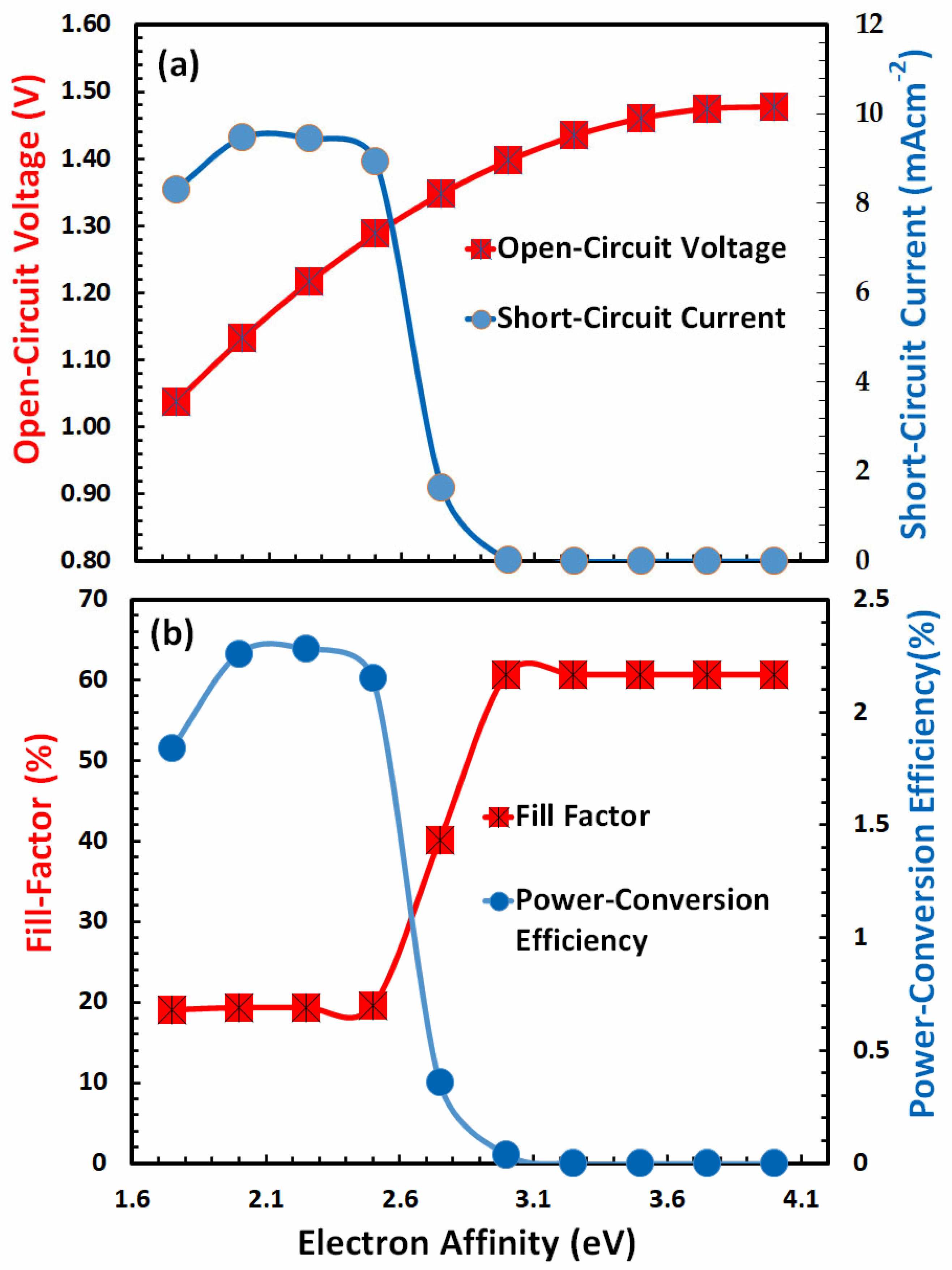
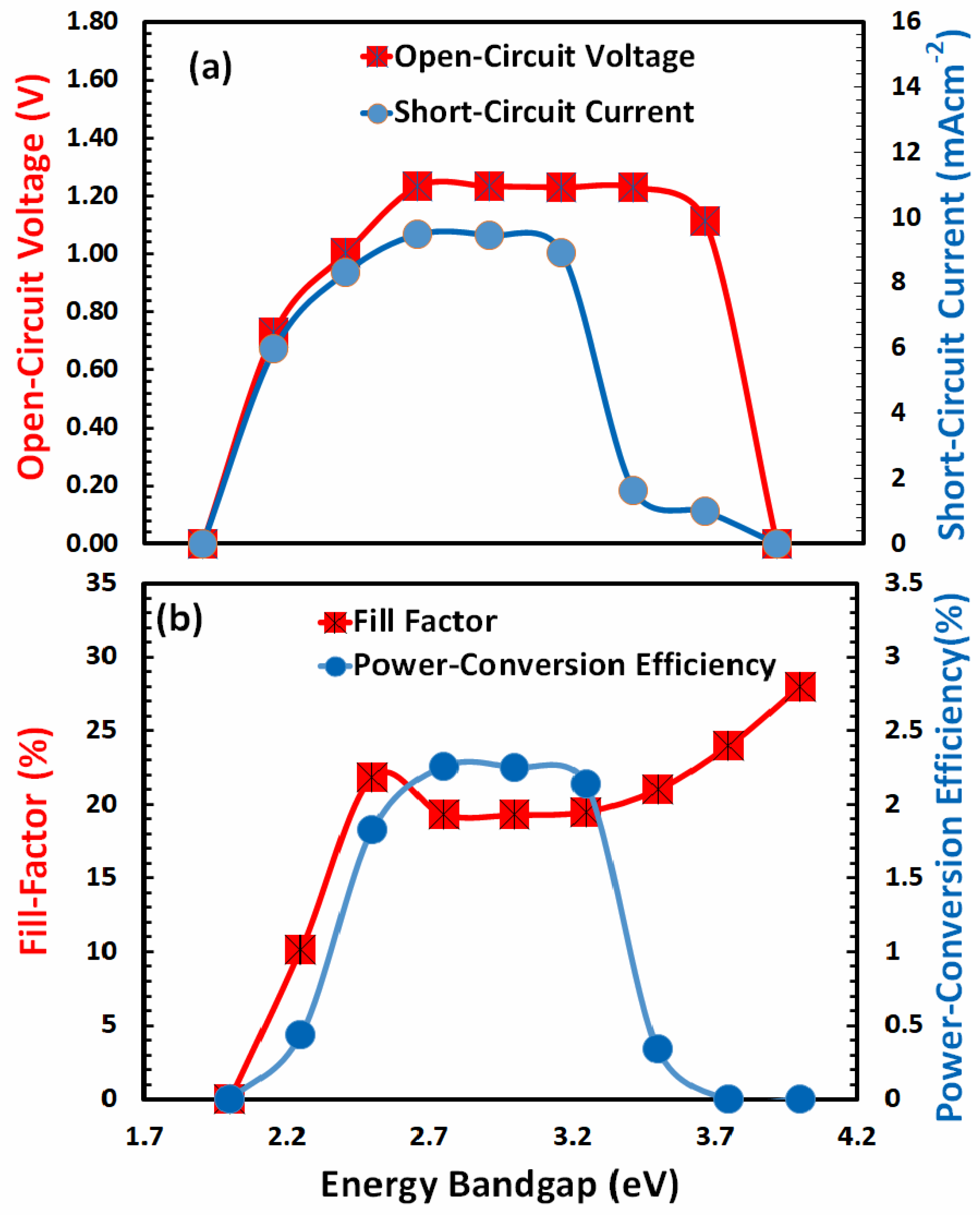
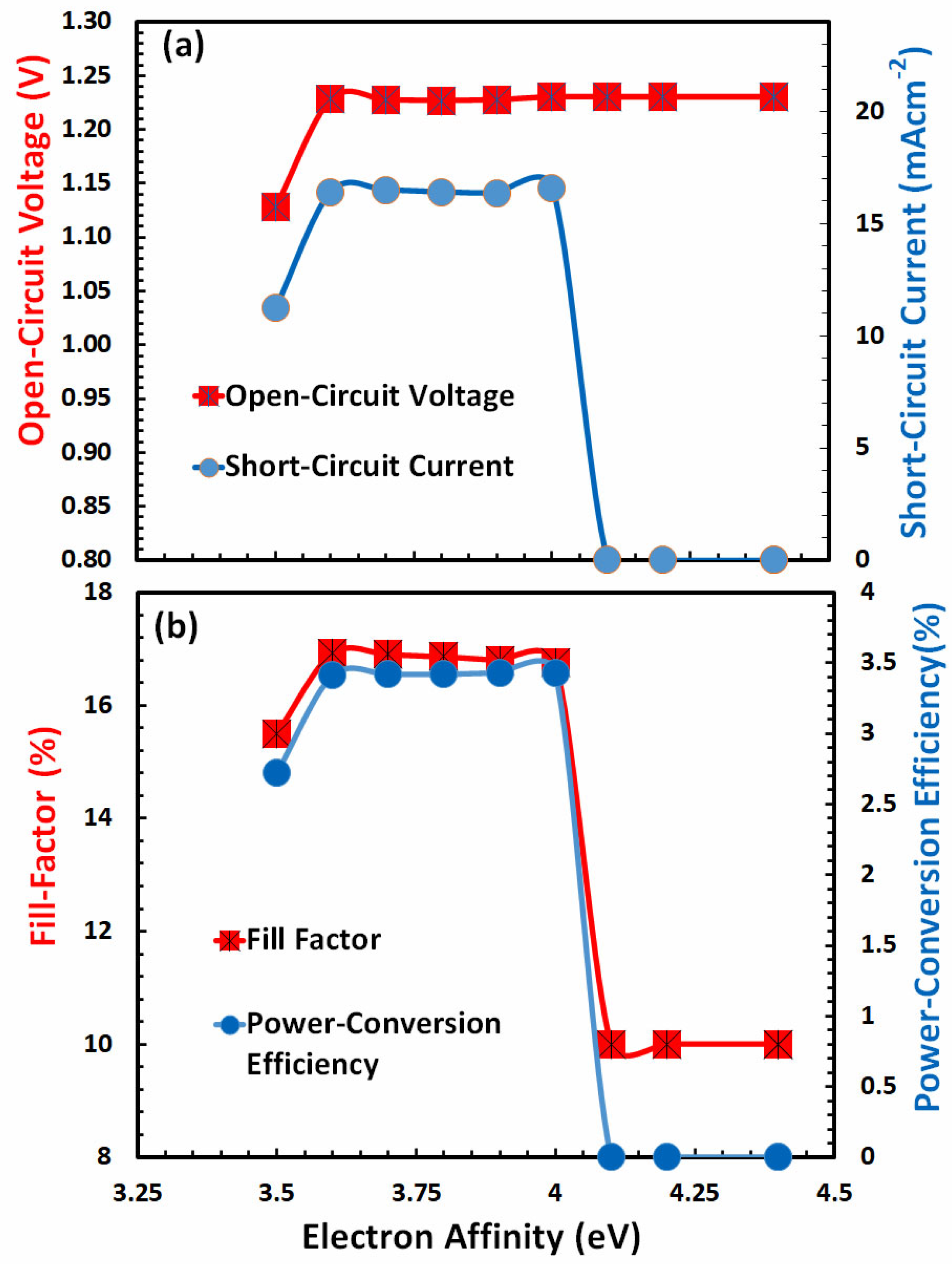
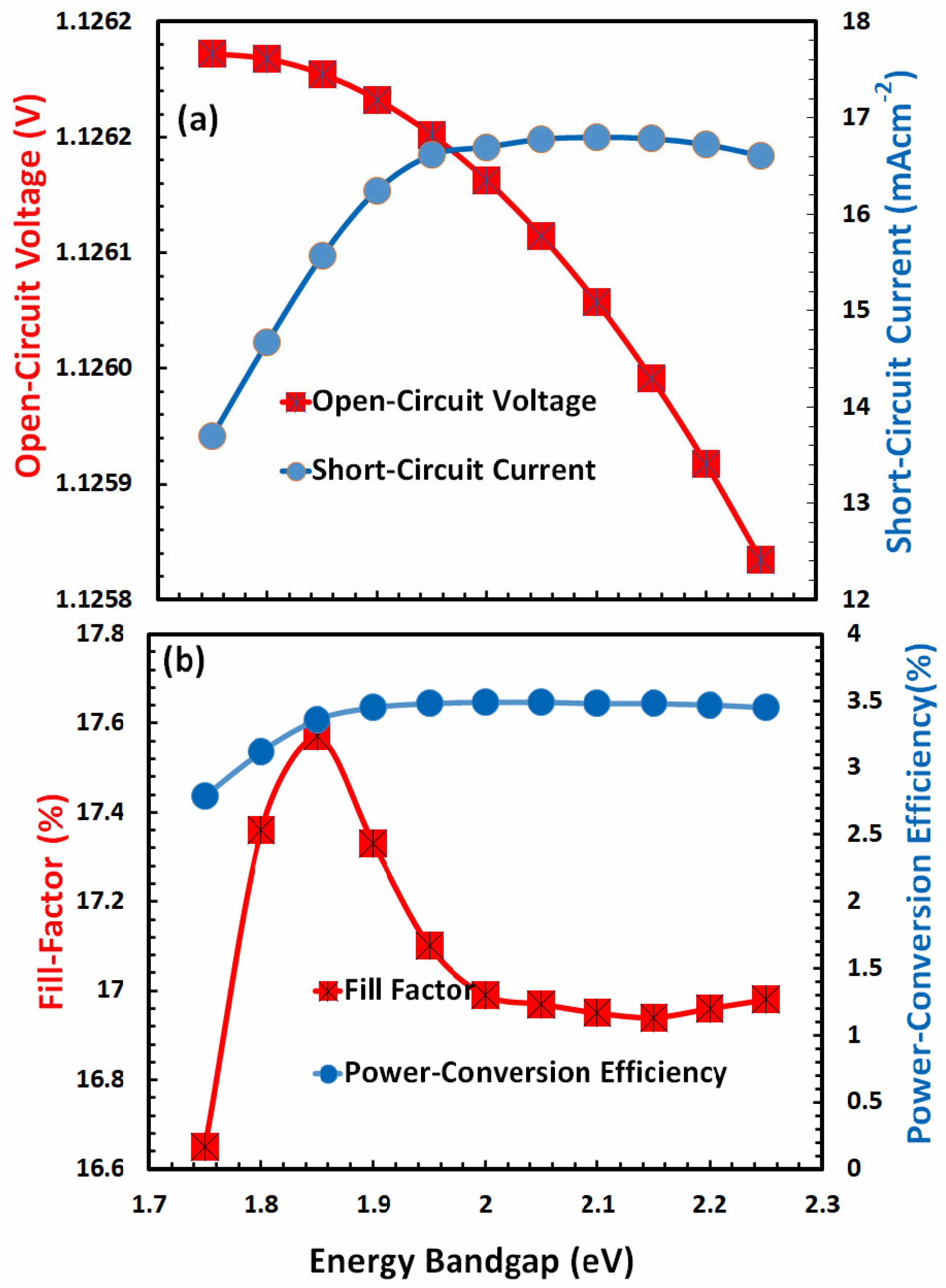
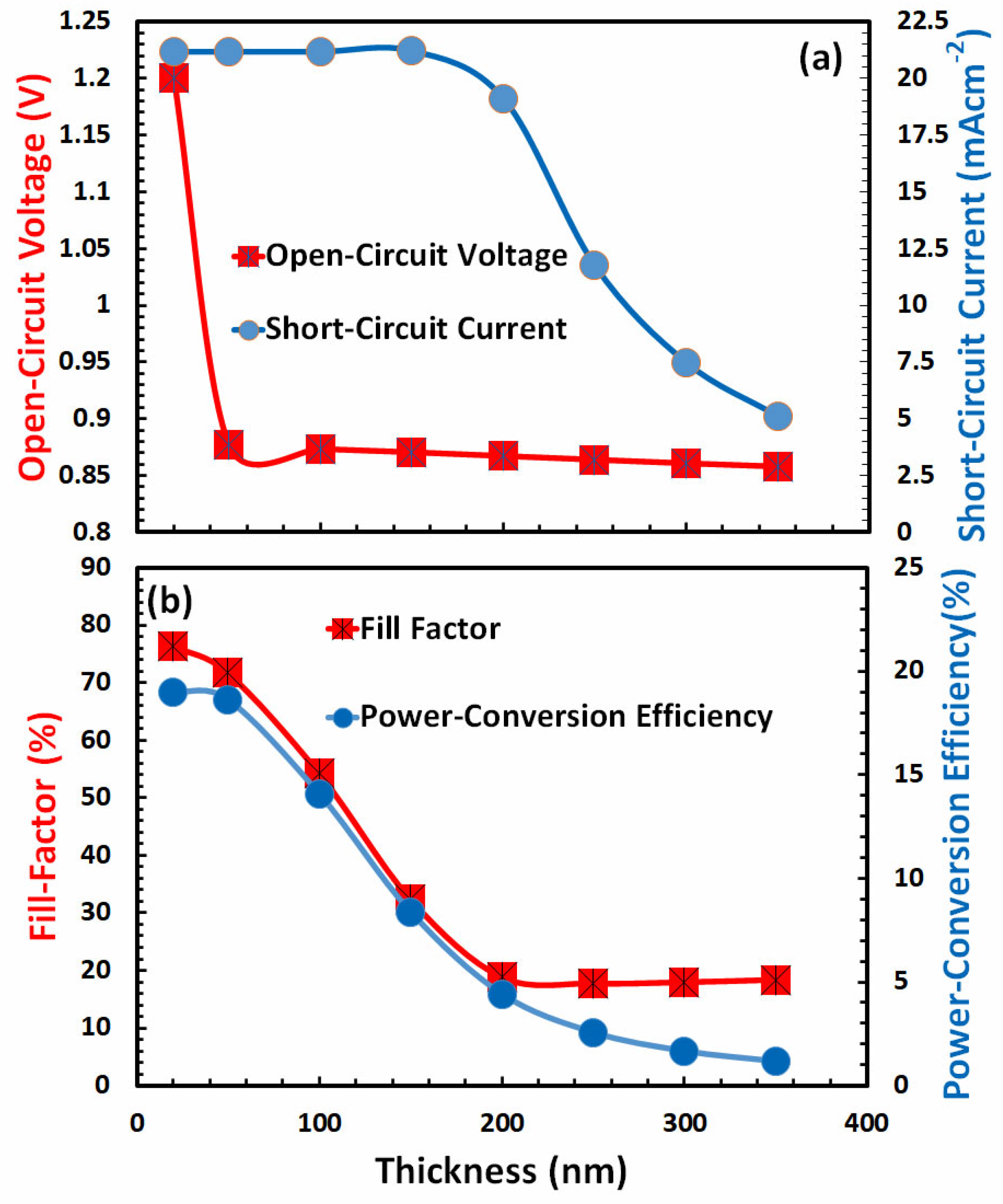
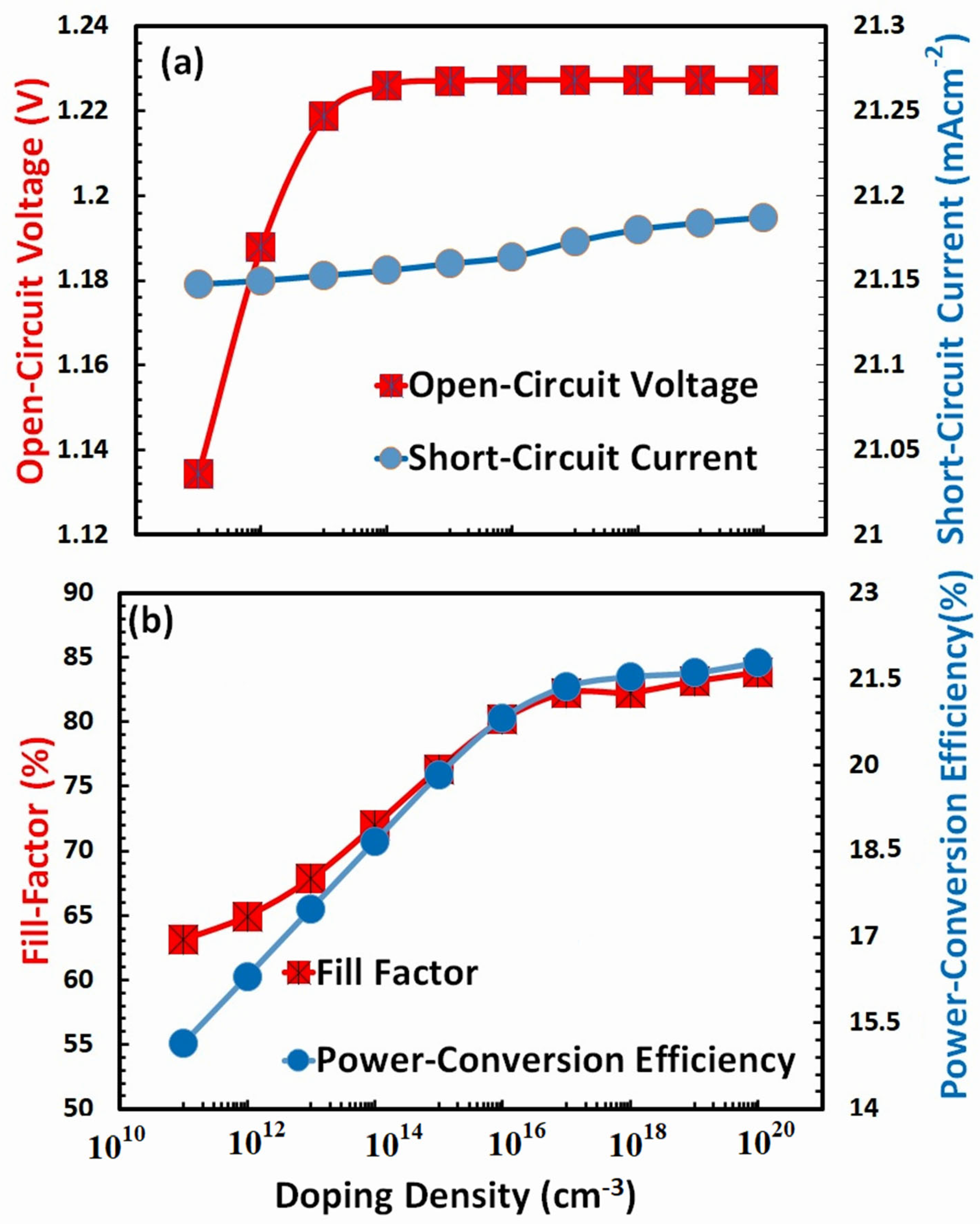

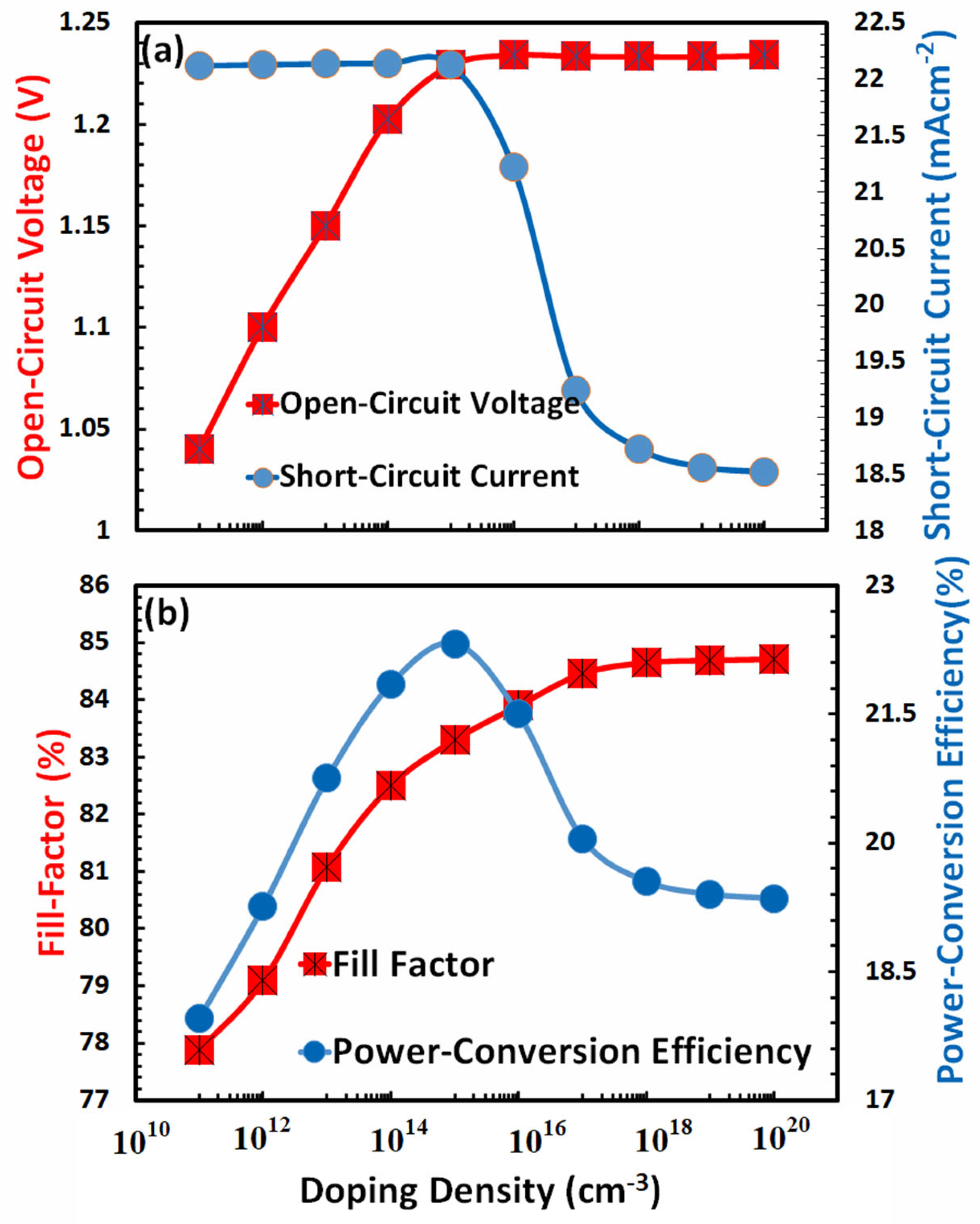

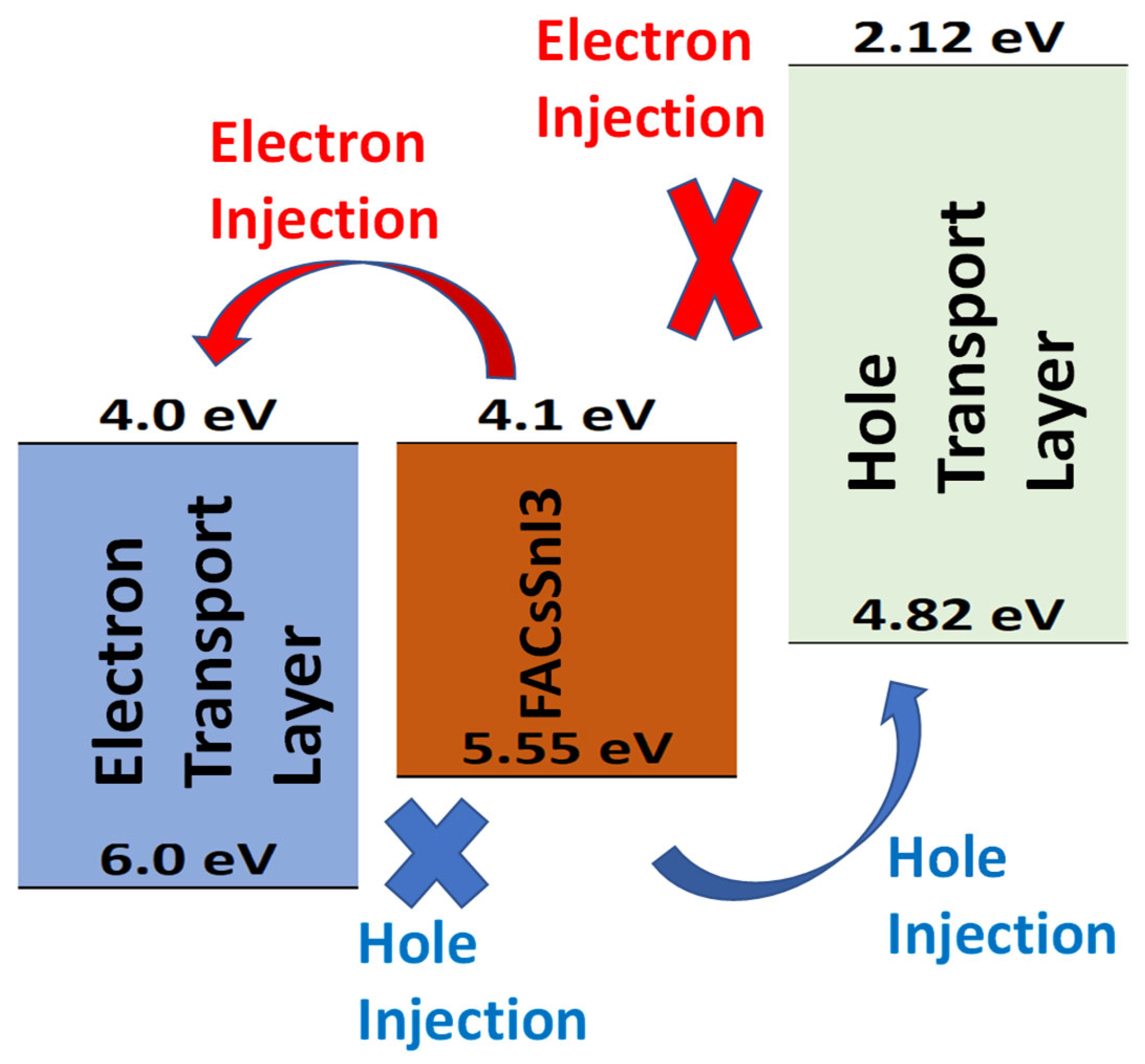

| Year | Author | Perovskite | HTL | ETL | PCE (%) | Ref |
|---|---|---|---|---|---|---|
| 2016 | Lee et al. | FACsSnI3 | Spiro-OMeTAD | TiO2 | 4.8 | [31] |
| 2016 | Lio et al. | FACsSnI3 | PEDOT:PSS | PCBM | 6.07 | [29] |
| 2018 | Kim et al. | FACsSnI3 | PEDOT:PSS | BCP | 7.66 | [32] |
| 2019 | Ran et al. | FACsSnI3 | PEG-PEDOT:PSS | C60 | 9.61 | [33] |
| 2020 | Nie et al. | FACsSnI3 | CuSCN | PCBM | 7.34 | [34] |
| 2021 | Yu et al. | FACsSnI3 | PEG-PEDOT:PSS | C60 | 9.0 | [35] |
| 2021 | Li et al. | FACsSnI3 | PEDOT:PSS | C60 | 10.4 | [30] |
| 2022 | Zillner et al. | FACsSnI3 | NiOx | PCBM | 6.76 | [36] |
| Transport Layer | Electron Affinity | Energy Band Gap | Thickness | Doping Density |
|---|---|---|---|---|
| (eV) | (eV) | (nm) | (/cm3) | |
| Hole Transport | 2.12 | 2.7 | 20 | 1020 |
| Electron Transport | 4.0 | 2.0 | 260 | 1016 |
| FACsSnI3 | - | - | 100 | - |
Disclaimer/Publisher’s Note: The statements, opinions and data contained in all publications are solely those of the individual author(s) and contributor(s) and not of MDPI and/or the editor(s). MDPI and/or the editor(s) disclaim responsibility for any injury to people or property resulting from any ideas, methods, instructions or products referred to in the content. |
© 2023 by the authors. Licensee MDPI, Basel, Switzerland. This article is an open access article distributed under the terms and conditions of the Creative Commons Attribution (CC BY) license (https://creativecommons.org/licenses/by/4.0/).
Share and Cite
Moiz, S.A.; Alahmadi, A.N.M.; Alshaikh, M.S. Lead-Free FACsSnI3 Based Perovskite Solar Cell: Designing Hole and Electron Transport Layer. Nanomaterials 2023, 13, 1524. https://doi.org/10.3390/nano13091524
Moiz SA, Alahmadi ANM, Alshaikh MS. Lead-Free FACsSnI3 Based Perovskite Solar Cell: Designing Hole and Electron Transport Layer. Nanomaterials. 2023; 13(9):1524. https://doi.org/10.3390/nano13091524
Chicago/Turabian StyleMoiz, Syed Abdul, Ahmed N. M. Alahmadi, and Mohammed Saleh Alshaikh. 2023. "Lead-Free FACsSnI3 Based Perovskite Solar Cell: Designing Hole and Electron Transport Layer" Nanomaterials 13, no. 9: 1524. https://doi.org/10.3390/nano13091524
APA StyleMoiz, S. A., Alahmadi, A. N. M., & Alshaikh, M. S. (2023). Lead-Free FACsSnI3 Based Perovskite Solar Cell: Designing Hole and Electron Transport Layer. Nanomaterials, 13(9), 1524. https://doi.org/10.3390/nano13091524







